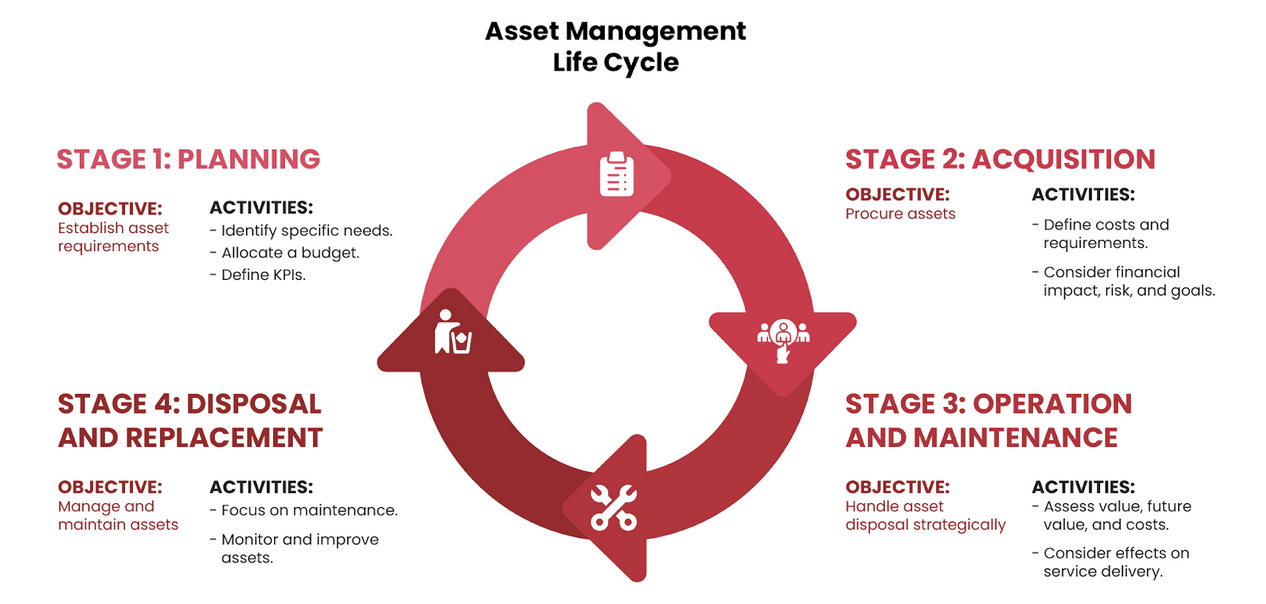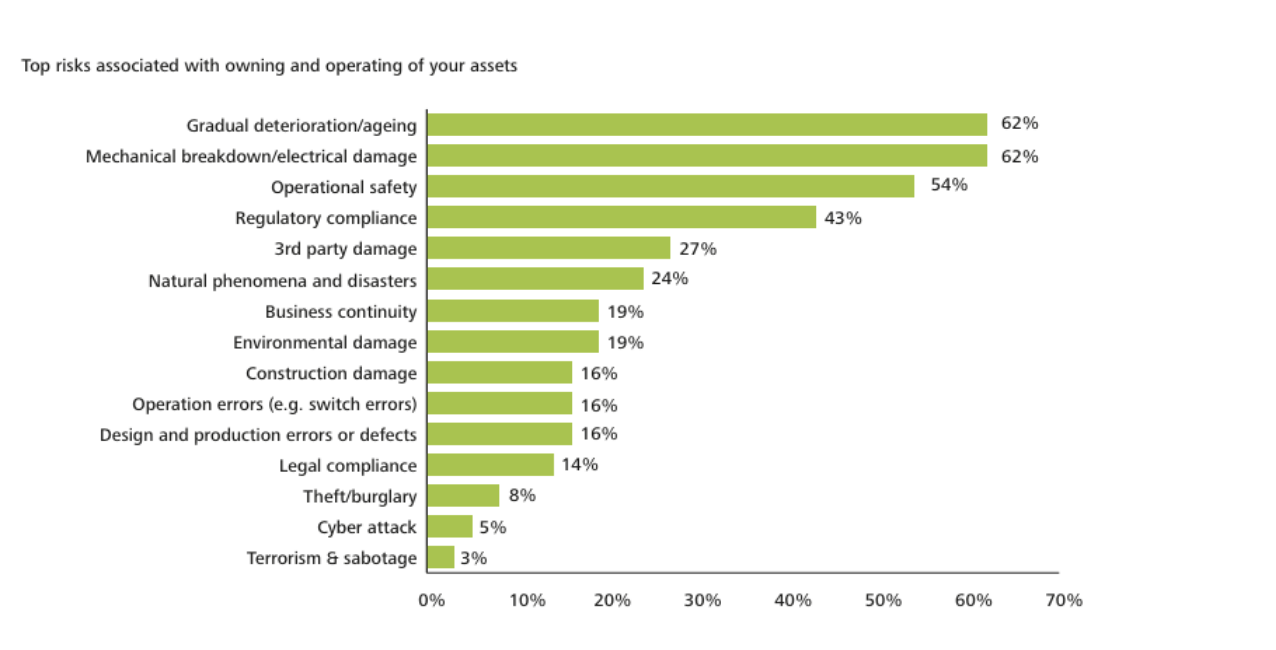Strategic Asset Management: The Ultimate Guide to Optimizing Your Assets
Strategic asset management helps you get the best value and performance for your assets, improving their lifespan and reducing breakdowns.
In this article:
- What Is Strategic Asset Management
- What Is the Importance of Asset Management
- 1. Better Decision Making
- 2. Reduced Total Cost of Ownership (TCO)
- 3. Increased Asset Utilization
- Key Components of Strategic Asset Management
- 1. Asset Inventory
- 2. Asset Prioritization
- 3. Lifecycle Management
- 4. Risk Management
- 5. Performance Monitoring
- Conclusion

Many factors contribute to an organization’s success, from committed employees and innovative ideas to streamlined operations. However, managing assets is the secret recipe that ties it all together, helping companies boost productivity and long-term profitability. Strategic asset management (SAM) allows you to optimize the performance and value of your assets throughout their lifecycle.
The practice integrates financial, operational, and strategic factors to ensure that every asset contributes to your organization’s goals. In fact, research suggests that companies can cut maintenance expenses by 12-18% with proper asset management, particularly through preventative maintenance. So, what is strategic asset management all about?
What Is Strategic Asset Management
Strategic asset management (SAM) is a data-based framework for managing an organization’s assets to earn the best return on investment (ROI). This approach aims to maximize the value, performance, and efficiency of your assets throughout their lifestyle, thereby contributing to your company's broad objectives. With an SAM framework, you get a detailed picture of current asset needs and anticipate future requirements over the next 5, 10, or even 20+ years.
In other words, SAM is centered around making informed, data-backed decisions regarding asset acquisition, utilization, maintenance, and disposal. This covers both physical assets like machinery, equipment, and buildings, and intangibles, including intellectual property and software. The goal is to extend the life cycle of assets, reduce downtime, and avoid expensive repairs in the long run.
What Is the Importance of Asset Management
Strategic asset management focuses on long-term investments in physical assets. It balances both operational and capital expenditures from a total expenditure (TOTEX) perspective. This approach helps organizations keep their equipment running for longer and in prime condition, avoiding costly repairs and breakdowns.
Here’s why you should have an IT asset management (ITAM) strategy:
1. Better Decision Making
When you have a detailed record of asset performance, condition, and costs, you’re able to make better decisions regarding asset acquisition and disposal. SAM also facilitates informed decisions about OpEx and STO.
2. Reduced Total Cost of Ownership (TCO)
By implementing asset management strategies like preventative maintenance and condition monitoring, businesses can prevent repairs and breakdowns. SAM also leads to better resource allocation.
3. Increased Asset Utilization
SAM tracks asset utilization and performance, which helps organizations track under-used or overused assets. This helps reallocate assets to where they are needed most, improving the return on asset (ROA).
Key Components of Strategic Asset Management
1. Asset Inventory
The first component of any strategic asset management process is having a detailed record of your inventory. If you don’t have an asset register already, use a “walk the floor” approach to log and label the pieces as you move. To streamline your asset inventory, it’s best to quit the spreadsheet method and migrate to an asset management software that reflects the following:
- How many assets do you own, and how much are they valued?
- Where are these assets located?
- What is the remaining useful life of each asset?
- What is the maintenance history of each asset?
- What are the conditions and performance levels of these assets?
2. Asset Prioritization
Once you have a logbook of all the assets you own, the next step is to prioritize these valuables based on how important they are to your operations. For example, in a 3D printing unit, the CNC machines are super critical because any downtime directly impacts production schedules and customer deliveries. On the contrary, office equipment like printers is not as important.
Here are a few other factors to consider when prioritizing the assets:
- Replacement Cost: Generally, the higher the replacement costs of an asset, the more it is prioritized for regular maintenance. This helps avoid the high replacement costs.
- Potential Impact: If an asset were to fail, how much impact would it have on your operations? This includes downtime, lost revenue, customer dissatisfaction, and reduced productivity.
- Organizational Impact: Think about the benefits each asset brings to the organization. If it directly improves productivity or product quality, prioritize it above other assets.
3. Lifecycle Management
The goal of lifecycle management is to extend the useful life of your asset by optimizing its performance in all aspects, from acquisition to disposal. This approach helps save costs and boost operational efficiency while improving the production rate of your asset. Lifecycle management also facilitates informed decisions about when to invest in new assets, when to upgrade existing ones, and when to retire outdated equipment.

Asset Management Life Cycle
4. Risk Management
Based on a survey by Deloitte, 62% of organizations think asset aging and mechanical breakdowns are primary risks in their asset management. Strategic asset management avoids these risks. The practice involves identifying, assessing, and mitigating risks right from the planning stage, improving the value and functionality of assets.

Different Risks Associated with Owning or Operating Assets
A strategic asset management plan accounts for risks, including:
- Operational risks (Equipment failure or breakdowns)
- Financial risks (Unexpected repair costs or budget overruns)
- Strategic risks (Regulatory shifts or market shifts)
Once the risks are identified, the next step involves developing strategies to minimize these risks. For example, you may schedule preventative maintenance checks to reduce the chances of equipment failures. Similarly, you can purchase comprehensive insurance to cover financial setbacks.
5. Performance Monitoring
When it comes to asset management best practices, one of the most crucial ones is performance monitoring. This practice ensures that your assets are functioning how they are supposed to, identifying any deviations from expected performance and taking corrective measures. The ISO 55000 standard mandates that all organizations report on the effectiveness and performance of their asset management program.
Conclusion
Strategic asset management is a must for any organization aiming to obtain the best combination of performance, value, and lifespan for their assets. By combining financial, operational, and strategic factors, SAM ensures that every asset contributes positively to the organization’s broad objectives.
If you want to boost your asset management and prevent costly failures, there’s no better option than migrating to Itefy’s Asset Management System. Itefy lets you schedule maintenance, track locations, and optimize asset utilization in no time. With features that extend the lifespan of your assets while keeping equipment loss at bay, Itefy is the one-stop solution for asset management.
So, start your 14-day free trial today and see how it helps you organize and manage your assets effortlessly!
